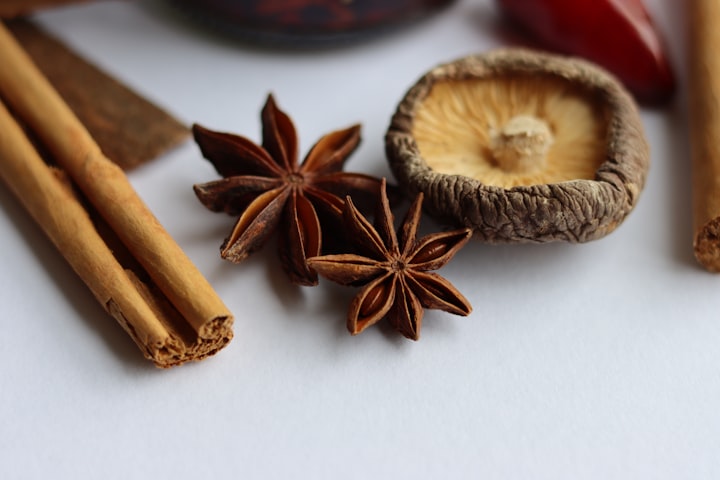The Timeless, Versatile Spice with Enchanting Form and Flavor
A journey through the culinary uses, health benefits, history and modern applications of the treasured star anise
Star anise, with its distinctive star-shaped appearance and rich, aniseed flavor, is a spice that has fascinated the culinary and medicinal worlds for centuries. Native to the evergreen trees of the Illicium verum plant in southwestern China and parts of Vietnam, star anise is a spice that is as versatile in use as it is unique in its form. In this exploration of star anise, we will delve into its culinary uses, health benefits, history, and even touch upon how to incorporate it into your cooking and daily life.
Introduction to Star Anise
The enchanting star anise is not only notable for its visual appeal but also for its potent flavor profile. Each of the eight segments of its star-shaped pod can contain a seed, but it's the pericarp, the pod itself, that holds the majority of the spice's fragrant oils, particularly anethole, which is responsible for the spice's deep, licorice-like flavor. A staple in Asian cuisine, star anise is one of the critical components of Chinese five-spice powder and is also a primary ingredient in Vietnam's celebrated pho broth.
Beyond its culinary applications, star anise has been praised for its myriad of health benefits. Traditional Chinese medicine has used it for centuries, and modern science is beginning to understand its potential. The spice is packed with antioxidants and vitamins and is known for its antiviral and antibacterial properties, making it a natural ally in the cold and flu season.
Culinary Uses of Star Anise
Star anise is a versatile ingredient that enhances the flavor of various dishes. Its sweet, yet spicy, licorice taste makes it a perfect addition to meat dishes, soups, and broths. It pairs exceptionally well with pork and duck, offering a depth of flavor that complements the natural richness of these meats. In vegetarian dishes, star anise adds a complexity that can mimic the savoriness typically provided by meat.
In baking, star anise can be a secret weapon, imparting a warm, exotic note to cookies, pastries, and bread. It can also be ground and added to spice blends for a unique twist on traditional flavors. For a simple application, one can infuse star anise in syrups or teas, providing a soothing and aromatic beverage that can calm the senses and aid digestion.
Health Benefits of Star Anise
The health benefits of star anise are as impressive as its culinary uses. It is rich in antioxidants, which fight free radicals and may reduce the risk of chronic diseases such as heart disease and cancer. Star anise also contains thymol, terpineol, and anethole, which are compounds that have been shown to have antifungal and antibacterial properties.
Star anise is often used as a remedy for digestive issues, including bloating, gas, and indigestion. The spice is thought to stimulate the digestive enzymes, which can lead to more efficient digestion and relief from discomfort. Additionally, star anise is a traditional remedy for coughs and colds. Its antiviral properties may help in the fight against the influenza virus, and its expectorant properties can help in loosening phlegm.
Historical Significance of Star Anise
The use of star anise dates back to ancient China, where it was not only a culinary staple but also a key component in traditional medicine. Its name, Illicium, translates to "allure," a nod to its enchanting aroma and flavor. The spice made its way along the Silk Road, reaching Europe and other continents, where it was initially used more for medicinal purposes than as a flavor enhancer.
Throughout history, star anise has been used to treat a variety of ailments, from rheumatism to colic to the plague. Its value was such that it was often used as a currency, a testament to the high regard in which it was held. In the 17th century, star anise was a precious commodity, and its trade was a significant economic driver for Chinese enterprises.
Incorporating Star Anise into Your Life
Incorporating star anise into your cooking and wellness routine can be simple and enjoyable. When cooking with star anise, remember that a little goes a long way due to its strong flavor. It's best used in slow-cooked dishes where it can infuse the meal with its distinctive taste. One can experiment by adding whole star anise to soups, stews, or braises, and removing it before serving.
For health benefits, star anise tea can be a comforting drink. Simply steep a whole pod in hot water for up to 15 minutes and enjoy a soothing, aromatic tea that may help with digestive issues or respiratory ailments. It's also possible to find star anise in capsule or oil form for more targeted therapeutic use.
Conclusion
Star anise is a spice that offers so much more than just a unique shape and flavor. Its culinary versatility and extensive health benefits make it a valuable addition to any kitchen or medicine cabinet. From its origins in ancient China to its modern-day applications in cooking and health, star anise has proven to be a spice of great worth and utility. Whether you are looking to enhance your next meal or seeking natural ways to support your health, star anise is a spice that deserves a place in your repertoire.






Comments
Rajeshkumar G is not accepting comments at the moment
Want to show your support? Send them a one-off tip.